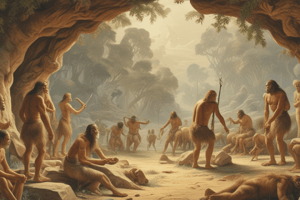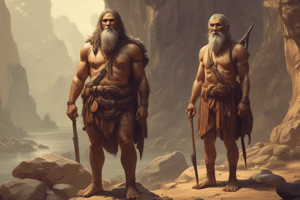Podcast
Questions and Answers
What was a significant outcome of the Agricultural Revolution?
What was a significant outcome of the Agricultural Revolution?
- The introduction of nomadic lifestyles
- The establishment of trade networks among hunter-gatherers
- The immediate decline of population growth
- Specialization in non-food producing activities (correct)
What was a common characteristic of the city-states in Mesopotamia?
What was a common characteristic of the city-states in Mesopotamia?
- They were predominantly nomadic societies.
- They were governed by a central pharaoh.
- They practiced monotheism.
- They built monumental structures called ziggurats. (correct)
How did the status of women in ancient Egypt compare to other civilizations?
How did the status of women in ancient Egypt compare to other civilizations?
- Egyptian women were typically less educated than men.
- Women in Egypt were solely responsible for household chores.
- Egyptian women were allowed to own property and had legal rights. (correct)
- Women in Egypt had no legal rights.
Which writing system was invented by the Sumerians?
Which writing system was invented by the Sumerians?
What was a primary factor in the development of governments in ancient civilizations?
What was a primary factor in the development of governments in ancient civilizations?
What key development did humans achieve during the period between 200,000 B.C.E. and 100,000 B.C.E.?
What key development did humans achieve during the period between 200,000 B.C.E. and 100,000 B.C.E.?
What factor contributed significantly to the global migration of humans by 10,000 B.C.E.?
What factor contributed significantly to the global migration of humans by 10,000 B.C.E.?
What was a significant consequence of the Agricultural Revolution that began around 8000 B.C.E.?
What was a significant consequence of the Agricultural Revolution that began around 8000 B.C.E.?
What aspect of early human societies showed signs of patriarchy?
What aspect of early human societies showed signs of patriarchy?
What belief system did early humans develop that was based on reverence for nature?
What belief system did early humans develop that was based on reverence for nature?
Flashcards are hidden until you start studying
Study Notes
The First Migrations
- Modern humans originated in East Africa between 200,000 and 100,000 B.C.E., relying on hunting and foraging.
- Lived in small, mobile groups without permanent homes, adapting to various environments.
- Developed stone tools, controlled fire, and created art, including drawings and paintings.
- Practiced animism, worshipping nature-associated deities, with early signs of male dominance (patriarchy).
- By 10,000 B.C.E., humans had spread to every continent except Antarctica.
The Agricultural Revolution
- Began around 10,000 B.C.E., coinciding with the warming climate post-Ice Age.
- Marked by the transition to agriculture, including crop planting and animal husbandry in the Middle East.
- Resulted in food surplus, allowing for specialization in occupations beyond food production.
- Enabled population growth and the formation of larger settlements that evolved into cities.
- Fostered technological advancements like improved irrigation, wheel usage, and metalworking.
- Led to the creation of governments and writing systems, driven by trade and taxation needs.
- Increased social stratification, with wealth-based class divisions; status of women generally declined.
The First Civilizations
-
Emerged from trends post-Agricultural Revolution, characterized by large societies, cities, and centralized power in river valleys.
-
Mesopotamia:
- Considered the world's first civilization, located between the Tigris and Euphrates rivers in present-day Iraq.
- Comprised various city-states, known for their patriarchy, monumental architecture (ziggurats), and polytheistic beliefs.
- Sumerians invented cuneiform, the first written language, for documenting laws and trade.
-
Egypt:
- Developed along the Nile River, characterized by centralized power under a pharaoh.
- Created hieroglyphics as a writing system, alongside advanced mathematics and monumental constructions like pyramids.
- Unlike many ancient societies, Egyptian women could own property and were legally equal to men, granting them a higher social status.
-
Indus Valley:
- Archaeological evidence points to advanced civilizations (Harappa and Mohenjo-Daro) along the Indus River in South Asia.
Studying That Suits You
Use AI to generate personalized quizzes and flashcards to suit your learning preferences.




